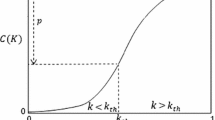Abstract
While percolation theory has been studied extensively in the field of physics, and the literature devoted to the subject is vast, little use of its results has been made to date in the field of hydrology. In the present study, we carry out Monte Carlo computer simulations on a percolating model representative of a porous medium. The model considers intersecting conducting permeable spheres (or circles, in two dimensions), which are randomly distributed in space. Three cases are considered: (1) All intersections have the same hydraulic conductivity, (2) The individual hydraulic conductivities are drawn from a lognormal distribution, and (3) The hydraulic conductivities are determined by the degree of overlap of the intersecting spheres. It is found that the critical behaviour of the hydraulic conductivity of the system,K, follows a power-law dependence defined byK ∞ (N/N c−1)x, whereN is the total number of spheres in the domain,N c is the critical number of spheres for the onset of percolation, andx is an exponent which depends on the dimensionality and the case. All three cases yield a value ofx≈1.2±0.1 in the two-dimensional system, whilex≈1.9±0.1 is found in the three-dimensional system for only the first two cases. In the third case,x≈2.3±0.1. These results are in agreement with the most recent predictions of the theory of percolation in the continuum. We can thus see, that percolation theory provides useful predictions as to the structural parameters which determine hydrological transport processes.
Similar content being viewed by others
References
Aharony, A., 1986, Percolation, in G. Grinstein and G. Mazenko (eds)Directions in Condensed Matter Physics, World Scientific, Singapore, pp, 1–50.
Aitchison, J. and Brown, J. A. C., 1957,The Lognormal Distribution, Cambridge University Press, Cambridge.
Balberg, I., 1986, Excluded-volume explanation of Archie's law,Phys. Rev. B 33(5), 3618–3620.
Balberg, I., 1987, Recent developments in continuum percolation,Phil. Mag. 56(6), 991–1003.
Balberg, I. and Binenbaum, N., 1985, Cluster structure and conductivity of three-dimensional continuum systems,Phys. Rev. A 31(2), 1222–1225.
Balberg, I. and Binenbaum, N., 1986, Direct determination of the conductivity exponent in directed percolation,Phys. Rev. B 33(3), 2017–2019.
Balberg, I., Wagner, N., Hearn, D. W., and Ventura, J. A., 1988, Critical behavior of the electrical resistance and its noise in inverted random-void systems,Phys. Rev. Lett. 60(19), 1887–1890.
Batchelor, G. K., 1967,An Introduction to Fluid Dynamics, Cambridge University Press, Cambridge.
Bear, J., 1972,Dynamics of Fluids in Porous Media, American Elsevier, New York.
Bear, J., Braester, C., and Menier, P. C., 1987, Effective and relative permeabilities of anisotropic porous media,Transport in Porous Media 2, 301–316.
Broadbent, S. R. and Hammersely, J. M., 1957, Percolation processes: 1. Crystals and mazes.Proc. Camb. Phil. Soc. 53, 629–641.
Carman, P. C., 1956,Flow of Gases Through Porous Media, Butterworths, London.
Doyen, P. M., 1988, Permeability, conductivity, and pore geometry of sandstone,J. Geophys. Res. 93(B7), 7729–7740.
Dullien, F. A. L., 1979,Porous Media: Fluid Transport and Pore Structure, Academic Press, New York.
Fair, G. M. and Hatch, L. P., 1933, Fundamental factors governing the streamline flow of water through sand,J. Amer. Water Works Accos. 25, 1551–1565.
Feng, S., Halperin, B. I., and Sen, P. N., 1987, Transport properties of continuum systems near the percolation threshold,Phys. Rev. B 35(1), 197–214.
Gueguen, Y. and Dienes, J., 1989, Transport properties of rocks from statistics and percolation,Math. Geol. 21(1), 1–13.
Halperin, B. I., Feng, S., and Sen, P. N., 1985, Differences between lattice and continuum percolation transport exponents,Phys. Rev. Lett. 54(22), 2391–2394.
Johnson N. L., 1949a, Systems of frequency curves generated by the method translation,Biometrika 36, 149–176.
Johnson N. L., 1949b, Bivariate distributions based on simple translated systems,Biometrika 36, 297–315.
Kim, D. Y., Hermann, H. J., and Landau, D. P., 1987, Percolation on a random lattice,Phys. Rev. B 35(7), 3661–3662.
Kogut, P. M. and Straley, J., 1979, Distribution-induced non-universality of the percolation conductivity exponents,J. Phys. C 12, 2151–2159.
Kozeny, J., 1927, Uber kapillare Leitung des Wassers im Boden,Sitzungsber. Akad. Wiss. Wien 136, 271–306.
Meyer, P. D., Valocchi, A. J., Ashby, S. F., and Saylor, P. E., 1989, A numerical investigation of the conjugate-gradient method as applied to three-dimensional groundwater flow problems in randomly heterogeneous porous media,Water Resour. Res. 25(6), 1440–1446.
Sen, P. N., Roberts, J. N., and Halperin, B. I., 1985, Nonuniversal critical exponents for transport in percolating systems with a distribution of bond strengths,Phys. Rev. B 32(5), 3306–3308.
Stauffer, D., 1985,Introduction to Percolation Theory, Taylor and Francis, New York.
Thompson, A. H., Katz, A. J., and Krohn, C. E., 1987, The microgenity and transport properties of sedimentary rock,Adv. Phys. 36(5), 625–694.
Wagner, N. and Balberg, I., 1987, Anomalous diffusion and continuum percolation,J. Stat. Phys. 49(1/2), 369–382.
Wong, P., 1988, The statistical physics of sedimentary rock,Physics Today, December, 24–32.
Wong, P., Koplik, J., and Tomanic, J. C., 1984, Conductivity and permeability of rocks,Phys. Rev. B 30(11), 6606–6614.
Author information
Authors and Affiliations
Rights and permissions
About this article
Cite this article
Berkowitz, B., Balberg, I. Percolation approach to the problem of hydraulic conductivity in porous media. Transp Porous Med 9, 275–286 (1992). https://doi.org/10.1007/BF00611971
Received:
Revised:
Issue Date:
DOI: https://doi.org/10.1007/BF00611971




